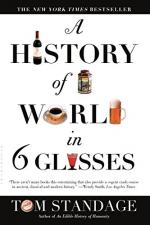|
This section contains 690 words (approx. 2 pages at 400 words per page) |

|
A History of the World in 6 Glasses Summary & Study Guide Description
A History of the World in 6 Glasses Summary & Study Guide includes comprehensive information and analysis to help you understand the book. This study guide contains the following sections:
This detailed literature summary also contains Topics for Discussion on A History of the World in 6 Glasses by Tom Standage.
“A History of the World in Six Glasses” by Tom Standage is a non-fiction work that traces the history of the six most important drinks that mankind discovered, developed and enjoyed throughout known history. These drinks often came at pivotal times in history or heralded in new eras and became symbols of the times or beliefs and emotions of the nations that they impacted.
Fifty-thousand years ago, hunter/gatherers lived nomadic lifestyles migrating to locations where they could hunt their prey and gather their fruit and nuts. A shift occurred about 12,000 years ago toward farming. Why this change occurred is not clear but it caused the tribes to forsake their nomadic lifestyles in favor of a settled and stationary existence. Once they stayed in one place, they discovered some unusual qualities about the grains they grew. Grains became sweet when soaked in water and when left exposed, they developed a fizzy, intoxicating quality. The farmers developed a pleasing liquid from their grains that they added to their soups and stews. Over time, the farmers drank the liquid instead of adding it to their soup. They had developed the world’s first beer.
It is thought that wine was first developed in the Neolithic period between 9000 and 4000 BCE in what is modern-day Armenia and Northern Iran. Three factors made the production of wine possible: the availability of wine grapes, support for the wine-making community. Wine was later developed in the ancient cultures of Mesopotamia and Egypt. There was a mystique about wine which many felt was linked to god and spiritual faith. The Greeks perfected the wine producing process and believed that Dionysus, the god of wine, had bestowed the drink upon them as a gift. The Greeks associated wine with intellect and sophistication a belief that is still held in many circles today.
The American colonists needed drink to get them through the ordeals of settling a new nation and fighting off Native Americans. Wine and beer were expensive imports and shipments of them were infrequent and unreliable. They turned to rum that was cheaper and easily to import from the Caribbean. The colonists were resourceful people, abandoned rum in favor of fermented wine which ultimately was developed into a new drink called whiskey. This new drink became the drink of choice of the colonists. They looked at it as a symbol of freedom and democracy. Everyone – rich or poor, smart or not so smart or young or old – could drink whiskey just like everyone could be liberated and independent.
Coffee was discovered in the Middle East but came into its own in England where there was concern about the overindulgence of intoxicating drinks. Coffee immediately became associated with the intellect, scientist and scholar. Coffeehouses sprung up all around London as a place for intellects to gather and discuss the latest news, exchange ideas and debate the issues of the day. Coffee is still associated with intellects and intellectual debate and coffeehouses (think Starbucks) still exist to this day. Although coffee was popular in London, when tea became more accessible, all of England fell in love with it. Every Brit had to have it every day. Tea rose to popularity at the same time Britain was rising to become the world’s first imperial superpower. Tea remains Britain’s most popular drink and symbolizes its days of glory.
When a pharmacist mixed the coca leaf with the kola nut and water, a dark fizzy liquid emerged. After perfecting the formula, this delightful soda water, called Coca-Cola, became an overnight sensation. During WWII, Coca-Cola was supplied to all the U.S. soldiers. Bottling plants were set up on military sites in foreign countries to satisfy the needs of the soldiers. After WWII, Coca-Cola was literally all over the world. It became the most popular soft-drink in the world and symbolizes what was good about America. Many of the soldiers who received a steady diet of Coke, wrote the company to express how having Coke symbolized home to them and what they were fighting for. Coca-Cola started as the number one soft-drink in the world and still holds that title.
Read more from the Study Guide
|
This section contains 690 words (approx. 2 pages at 400 words per page) |

|



